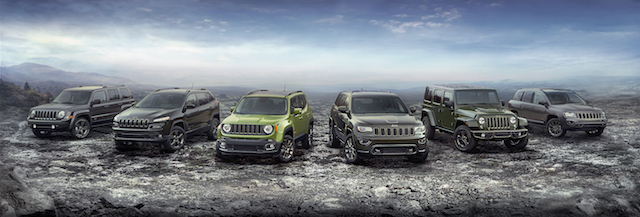
Among the military-themed exterior colours in Jeep’s line-up of 75th anniversary models this year is ‘Sarge Green’, a reference to a famous sketch honouring the original Jeep’s role in World War II.
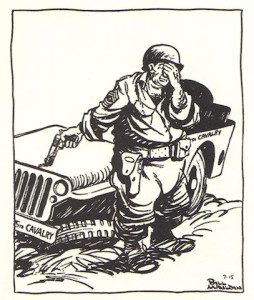 It was penned in 1944 by Bill Maudlin, a soldier in the US Army who created ‘Willie and Joe’, a newspaper cartoon strip about the lives of two typical US infrantrymen during the war in Europe.
It was penned in 1944 by Bill Maudlin, a soldier in the US Army who created ‘Willie and Joe’, a newspaper cartoon strip about the lives of two typical US infrantrymen during the war in Europe.
Mauldin shows a US cavalry ‘Sarge’ (sergeant) symbolically ‘putting down’ his broken Jeep with a Colt .45 pistol – just as a cavalry man from another age would ‘put down’ his broken horse. Such was the respect Allied soldiers had for the Jeep.
Sarge Green, Recon (Reconnoiter) Green, and Jungle Green are the three military-themed shades in the palette of colours for the 75th anniversary Wrangler, Cherokee, Grand Cherokee, Patriot, Compass and Renegade models. All six (above) will go on sale in New Zealand later this year.
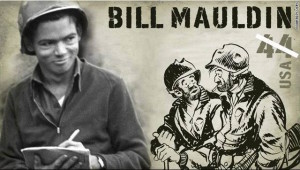
Other special-edition add-ons include bronze wheels, bronze and orange exterior accents, and a 75th anniversary badge. The interiors get the birthday treatment, too. The Wrangler offers optional heavy-duty Dana axles and optional gear ratios for serious off-road work.
“There is no better way to mark 75 years of Jeep in 2016 than with a special edition of each of the models that wear the Jeep name,” said David Smitherman, CEO of Fiat Chrysler New Zealand. “Therefore we are pleased to confirm that these special editions with be the centre piece of our celebrations.”
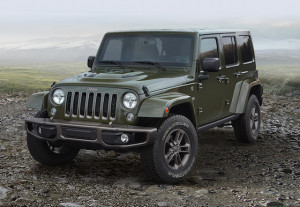
The birthday editions are badged to cash in on the rich heritage of the Jeep name, now watered down from its all-American origins by the use of global components cobbled together to complete an expanded range for Jeep owner Fiat Chrysler Automobiles.
For example, a Fiat chassis underpins the Cherokee, Patriot, Compass and Renegade; a modified Mercedes-Benz platform – a hangover from the short-lived Daimler-Chrysler union – supports the Grand Cherokee.
The Wrangler is the only Jeep with a dedicated, made-in-America chassis. Mike Manley, the US head of the Jeep brand, has said Wrangler owners insist on it. It is also the only Jeep that bears any resemblance to the original production model, built in 1941.
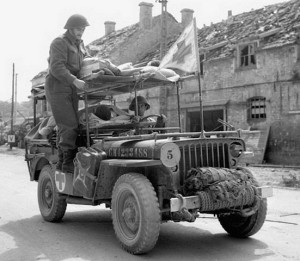
Back then it became the Allied army’s greatest sidekick. US General Dwight Eisenhower – later to be US president – said the Jeep, the Douglas DC 3 aircraft, and the amphibious landing craft, were the three most important machines of the Allied cause.
Jeep came about in 1940 when the US Government – knowing that entry into the war looked likely – asked its automotive industry for an all-purpose four-wheel-drive vehicle with a load capacity of 270kg. It gave it six or so weeks to come up with a prototype. The small Bantam company’s design was first and it was awarded the contract.
But Bantam didn’t have the production resources to mass-produce its vehicle, so the government handed Bantam’s blueprints to Willys-Overland and Ford, two companies that had also built prototypes. In the end the Willys was the clear winner – “superior in acceleration, maximum speed, grade climbing and cross country,” the government concluded. It weighed just under 1000kg.
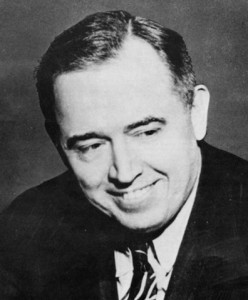
The clincher was the Willys engine, a 2.2-litre four-cylinder unit that delivered 44kW at 4000rpm and 142Nm at 2000rpm – but only after being rebuilt by Willys engineer Barney Roos, who had worked for Pierce-Arrow, Studebaker and the British Rootes Group.
New Yorker Roos was a past president of the Society of Automotive Engineers. He joined Willys in 1938, when the company was going broke and needed a low-cost miracle. Roos found it in the form of a 2.2-litre four-cylinder engine built in 1926 for the Willys ‘Whippet’ sedan, which at one stage was the third best-selling car in the US.
But the Whippet’s 33kW/120Nm engine proved to be its weakness. It leaked oil every which way, cooked bearings, and vibrated so much it could shake loose its starter motor.
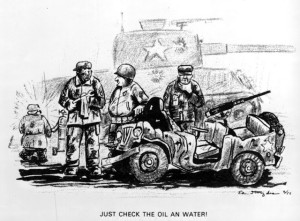 Roos pretty much rebuilt it to create closer tolerances. Critically, he increased the diameter of the intake manifold, replaced the cast-iron pistons with aluminium ones, took weight out of the flywheel, strengthened the crankshaft, fitted graphite bearings and manganese springs, boosted the compression ratio, and modified the cooling system.
Roos pretty much rebuilt it to create closer tolerances. Critically, he increased the diameter of the intake manifold, replaced the cast-iron pistons with aluminium ones, took weight out of the flywheel, strengthened the crankshaft, fitted graphite bearings and manganese springs, boosted the compression ratio, and modified the cooling system.
He ran it on a test bench ‘wide open’ at a constant 4400rpm for 100 hours. It didn’t miss a beat. Thereafter it was called the ‘Go-Devil.’ The original ‘Whippet’ engine was tested at 3400rpm – bearings burned out after 22 minutes.
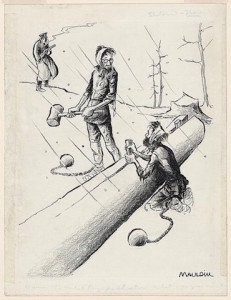 By the end of WWII and beyond, the US had built around 650,000 Jeeps – Willys 350,000, Ford 280,000, and Bantam 2675. More than 150,000 had been shipped under the US Lend–Lease aid programme to America’s British and European allies, including roughly 50,000 to Russia.
By the end of WWII and beyond, the US had built around 650,000 Jeeps – Willys 350,000, Ford 280,000, and Bantam 2675. More than 150,000 had been shipped under the US Lend–Lease aid programme to America’s British and European allies, including roughly 50,000 to Russia.
The Soviet state’s propaganda machine said the Jeep was a Russian invention, built in a secret factory in the Ural Mountains. Cartoonist Maudlin, ever the admirer of the Jeep, later got to ridicule authoritarian Russia.
He won a Pulizter Prize in 1959 for a cartoon (right) about imprisoned Russian author Boris Pasternak. It shows two prisoners at work in a Siberian winter. One says to the other: ‘I won the Nobel Peace Prize for literature. What’s your crime?’
